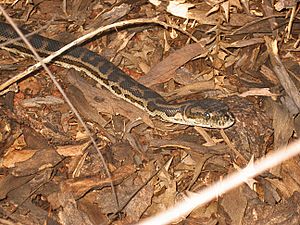Morelia imbricata facts for kids
Quick facts for kids Morelia imbricata |
|
|---|---|
 |
|
| Scientific classification | |
| Genus: |
Morelia (snake)
|
| Species: |
imbricata
|
| Synonyms | |
|
|
The Morelia imbricata is a large snake. It lives in southern Western Australia and western South Australia. This snake is part of the python family. People often call it the Southwest carpet python.
Contents
About the Southwest Carpet Python
The Southwest carpet python belongs to the Pythonidae family. It is related to other Australian diamond and carpet pythons. These snakes are all part of the Morelia group. There are six different Morelia species found across Australia.
What Does It Look Like?
This snake can grow quite long. Its total length can be up to 2.3 metres (7.5 feet). From its snout to its tail vent, it can be 2.0 metres (6.6 feet) long. This python has a clear neck and small scales on its head.
Male pythons can weigh up to 1.1 kilograms (2.4 pounds). Female pythons can be four times heavier when they are fully grown. Some very large snakes have been recorded up to 4 metres (13 feet) long.
How to Tell It Apart
Other similar pythons live in the same areas. The woma python, Aspidites ramsayi, does not have a clear neck like the Southwest carpet python. The western Stimson's python, Antaresia stimsoni stimsoni, has more scales on its belly.
Where Does It Live?
The Southwest carpet python lives in many different places. You can find it in coastal areas, woodlands, heathlands, and semiarid areas. It often lives in forests with eucalypt and Banksia trees. It also likes areas with grasses or low-growing shrubs.
How Does It Behave?
This python is usually quiet and moves slowly. It spends most of its time hiding. Sometimes, people see it trying to cross roads. These pythons usually stay in one place. However, females on Garden Island were seen moving around most of the year.
Morelia imbricata often makes its home in deep cracks or holes. These can be in limestone rocks or granite. They also hide in thick heath plants and animal burrows.
What Does It Eat?
This snake eats a variety of animals. Its diet includes geckos, house mice, and birds. It also eats small marsupials, like the Tammar wallaby. Young red-eared firetails, Stagonopleura oculata, have been eaten from their nests.
Its Home Range
Individual pythons can have a large area where they live. In cooler months, they might stay in hollow logs. They can also wander across areas as big as 20 hectares (50 acres). Male pythons usually have a larger home range than females.
These snakes seem to return to the same hiding spots. They do this even after being away for a long time. This habit might make them more vulnerable to danger.
Protecting the Southwest Carpet Python
The Morelia imbricata is found over a wide area. It is thought to have many individuals. However, it faces threats in its habitat. Clearing land and changes in how fires are managed are big problems. This snake needs large, undisturbed areas to live.
We don't fully know the impact of introduced predators. Foxes and cats are known to hunt these pythons. The number of pythons has gone down in the Esperance region. Different groups have assessed its conservation status. It has been called 'near threatened' by the Red List (in 2000). It is also listed as 'specially protected fauna' under the region's Wildlife Conservation Act. The hollow logs that these pythons like are not being created due to new fire patterns or land clearing.
Where Can You Find It?
This python lives across all of Southwest Australia. This area has a typical mediterranean climate. It also extends into central dry and semidry regions. Its northern limit is Northampton, north of Geraldton. To the east, it can be found as far as the Eyre Peninsula.
The python also lives on islands. These include the Houtman Abrolhos, Garden Island, and the Archipelago of the Recherche. There are also records of this snake on St Francis Island in South Australia's Nuyts Archipelago.
- Morelia imbricata at the TIGR Reptile Database. Accessed 15 February 2021.

